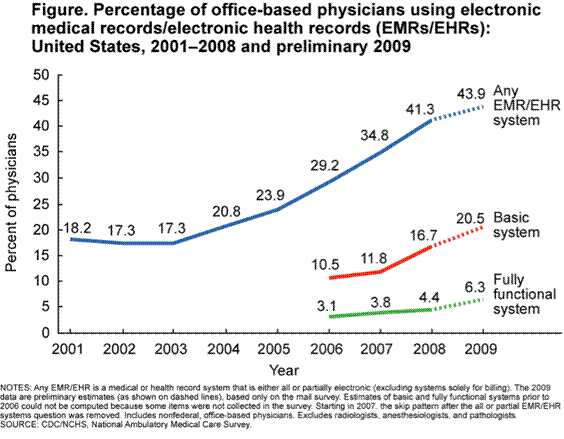|
The foundation of modern healthcare began before the 19th Century, but patient medical records really began in the 1800s. That history can be briefly summarized in three steps:
- 19th Century records, such as they were, were produced by pencil and paper.
- 20th Century records were produced at their best by dictation and transcription.
With the advent of extensive technologically-based care and with expanded access to care, these methods became obsolete. Even in the last quarter of the 20th Century, it became obvious that old methods of documenting, storing, sharing and using of healthcare information and of medical records were inadequate. In the 21st Century, excellence in medical records was going to be electronic.
While healthcare providers began using computers for billing and collections and for some simple health data in the 1980s, electronic medical records (EHR) were not widely used before 2008 and later. As can be seen from the following chart, as late as 2009, barely 6% of physicians, nationally, were using “fully functioning EHRs.” Southeast Texas providers largely did not start using EHRs widely until 2010 and later.

There was an exception. In March, 1998, Southeast Texas Medical Associates, LLP (SETMA) purchased one of the first, if not the first, EHR systems in Southeast Texas. When SETMA wrote a check for $650,000 for the first step in this process, many thought it was a waste of money and that it would have no benefit for patient care. Time would disprove that judgment.
Over the next sixteen years, SETMA would be awarded in part:
- 2003 Microsoft Healthcare Users Group 2003 MS-HUG Annual Award acknowledging Healthcare-Industry Leaders- and Organizations’ Practical Uses of Microsoft Technology.
- 2003 SETMA named Southeast Regional Physician Practice Magazine Clinic of the year.
- 2005 SETMA named Physician Practice Magazine National Runner€“up Clinic of the year
- 2005, SETMA award the HIMSS’ Davies Award prestigious award for Excellence in Electronic Health Records
- 2010 SETMA Awarded HIMSS Tier 1 Designation for Stories of Success, a pier reviewed award by HIMSS, American Society for Quality (ASQ), National Committee for Quality Assurance (NCQA) and National Patient Safety Foundation (NPSF)
- 2011 Agency for Healthcare Research and Quality of Health and Human Services published SETMA’s Clinical Decision Support LESS Initiative on their Innovation Exchange.
- 2011 HIMSS Meaningful Use Case Study of SETMA, LLP was published.
- 2012 eHealth Initiative Named SETMA as innovator of the Year
- 2012 SETMA Selected One of the top 30 Exemplar Ambulatory Practices for
The Robert Wood Johnson Foundation’s Project LEAP (Learning from Exemplar Ambulatory Practices) and recognized as a National Model of Innovative Primary Care Practice
- 2012 HIMSS named SETMA’s CEO, Physician Information Technology Leadership Award Winner
- 2013 American Medical Informatics Association awarded SETMA the December 2013 Pi2 Award for Clinical Decision Support.
- 2014 €“ SETMA named NCQA Triple Crown Winner for IT and Performance Excellence
But for SETMA, the turning point was May of 1999. In that month SETMA:
- Determined that EHR was to hard and too expensive if all that could be done was to document a patient encounter electronically; therefore SETMA changed to leveraging the power of electronics to improve patient and population health, i.e., electronic patient management.
- Began developing disease management tools and clinic decision support.
- Began celebrating change, continuously expecting improvement in process and outcomes of care.
- Defined ten principles which would guide SETMA’s growth and development which would result in SETMA becoming an accredited Patient-Centered Medical Home in 2010.
- Published a booklet entitled, More Than a Transcription Service: Revolutionizing the Practice of Medicine: And Meeting the Challenge of Managed Care With Electronic Medical Records (EMR) which Evolves into Electronic Patient Management, which guided their development.
The result of this history and development is that today SETMA has six clinics across Southeast Texas, all connected electronically with four hospitals, 27 nursing homes, four emergency departments, a hospice, a home health, and a physical therapy, so that rather than being locked up in an office like paper records, SETMA’s records are available where ever and when ever a patient needs care.
SETMA is able to calculate patient’s heart risk scores and to produce a plan-of-care and treatment-plan which maximizes health and longevity. The promise of that initial investment which has been increased to over $8,000,000 for record accessibility, security, speed and excellence, makes SETMA’s original decision appear to be prescient. And, for the citizens of Southeast Texas it provides award-winning care, which is equal to that available anywhere in the world and care which is superior to most.
|